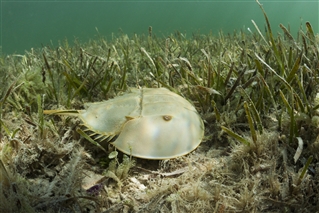Horseshoe Crabs, Living Fossils Used as Blood Donors

Around half a million Atlantic horseshoe crabs (Limulus polyphemus) a year are being taken from the wild, scrubbed clean and then drained of up to a third of their blood. Those that survive this ordeal, around two thirds, are then transported back to the water and released. However, it is not known exactly how many of these remain alive. The crabs may be unable to find their original feeding areas and the females might not lay so many eggs. They can lay about 90,000 eggs, of which perhaps only ten will make it to adulthood.
The horseshoe crab’s blood contains cells (limulus amebocyte lysate or LAL) that can quickly detect bacteria, so it is used to make sure that injectable drugs, medical instruments etc. are not infected prior to use. There have been synthetic alternatives available for many years but they have not been utilised for various reasons. LAL is currently part of the process helping scientists to research a potential COVID-19 vaccine.
The IUCN classified the horseshoe crabs as Vulnerable in 2016 and populations are decreasing. The main threat at present is over harvesting (they are also used for bait and fertiliser). Additionally, they are increasingly at risk from habitat loss, pollution and climate change (rising sea levels). Migratory shorebirds will also be in danger, as they eat the eggs that horseshoe crabs lay on sandy beaches; with some bird species not having a alternative food source. Sea turtles also eat the eggs and larvae.
